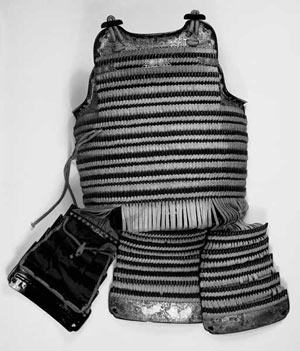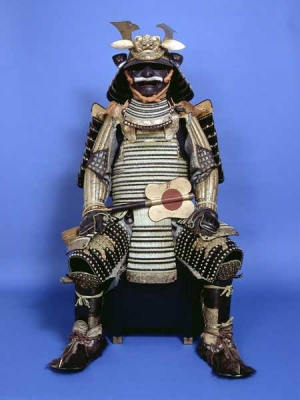General's armour (1901.46.1)
 JapanGeneral's armour from Japan, Asia. Thought to have been collected by Henry Martin Gibbs. Given to the Museum in 1901.
JapanGeneral's armour from Japan, Asia. Thought to have been collected by Henry Martin Gibbs. Given to the Museum in 1901.
This very ornate suit of Japanese parade armour dates to around 1750, the middle of the Tokugawa Shogunate (Edo period), 1603-1867. It consists of scores of separate pieces including a 32-plate helmet with a peak demon crest, a war fan, inner and outer boots, chain mail gloves, mempo (face mask) and underneath would have been worn silk breeches and a jacket, padded and reinforced with chain mail.
Warrior Elite
There are many clues suggesting this is the armour of a particularly high-ranking warrior (bushi) of the samurai class; either a feudal lord (daimyo), or one of his generals (taisho). The iron war-fan was a symbol of high military rank, used by generals to direct troops on the battlefield and also served as a makedshift weapon. The bearskin boots are mounted with ornamented brass splints to prevent cuts to the foot. The material of a samurai warrior’s footwear was rigidly controlled, and reflected his social status; bearskin was the most prestigious material in that hierarchy. Also visible on the helmet turnbacks (and repeated all over this armour) is a heraldic badge known as mon. The flower-like mon shown here denotes an high-status individual since it was used by several prestigious families.
 View of the inside of the armour. Three velvet pockets with ties line the 'skirt' section.Suspicious of the political instability of the feudal daimyo system, the Tokugawa Shoguns placed many controls and obligations on the lords, largely to curb their independence and tendency to revolt. During the early Tokugawa period, Japan enjoyed unprecedented internal peace, and the entire samurai class underwent a significant change from practical to symbolic warriorhood, becoming administrators and diplomats rather than warlords. One requirement was for each feudal lord to journey from his lands to the court at Edo, and remain there for half of each year. This practice promoted a culture of extensive annual parading back and forth to the capital, giving the lord and his samurai a chance to show off in ornate ‘parade’ armour.
View of the inside of the armour. Three velvet pockets with ties line the 'skirt' section.Suspicious of the political instability of the feudal daimyo system, the Tokugawa Shoguns placed many controls and obligations on the lords, largely to curb their independence and tendency to revolt. During the early Tokugawa period, Japan enjoyed unprecedented internal peace, and the entire samurai class underwent a significant change from practical to symbolic warriorhood, becoming administrators and diplomats rather than warlords. One requirement was for each feudal lord to journey from his lands to the court at Edo, and remain there for half of each year. This practice promoted a culture of extensive annual parading back and forth to the capital, giving the lord and his samurai a chance to show off in ornate ‘parade’ armour.
In the early 18th century, the master armourer Arai Hakuseki wrote a treatise deploring the decline of the ‘great armours’ of medieval times, arguing that the sight of a general wearing imposing antique armour was of tactical morale-boosting value to an army. This caused a major change in armouring styles, which prioritised display but looked to the past for inspiration. By 1800, such parade armours were criticised as showy and impractical and the 19th century saw a return to more functional styles





